Flowering Once In A Lifetime….
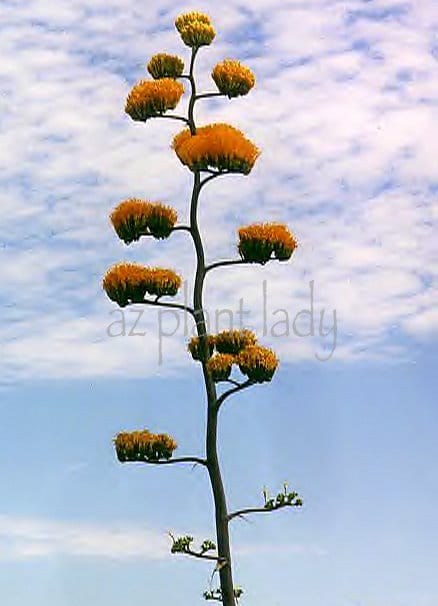
Imagine a plant that lives for years, never flowering, and then towards the end of it’s life, expends all of it’s energy to produce flowers on a giant stem and then dies….
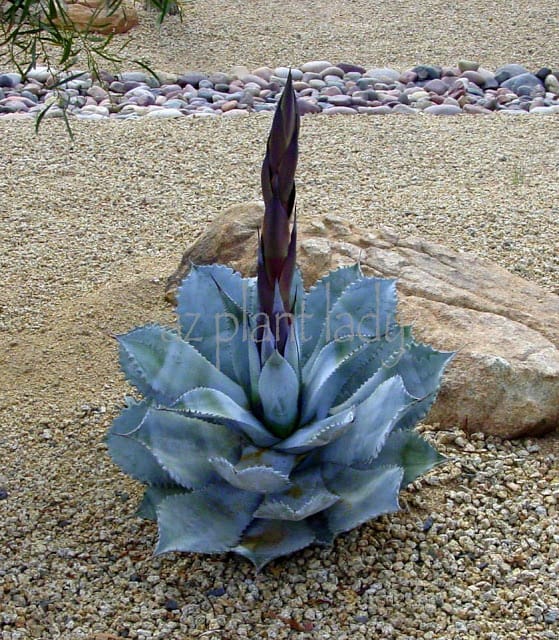
Agave colorata getting ready to flower.
Agave Stalks Begin Growth
The story begins with an agave starting to grow it’s flowering stalk, or inflourescence. The growth is incredibly fast, growing up to 1 ft. each day. Depending on the species, the flowering stalk can reach heights up to 40 ft.
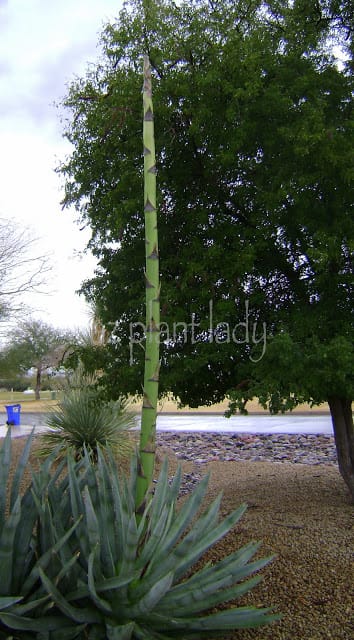
Agave murpheyi sending up it’s flower stalk. *I took the picture, above, at a client’s house and she referred to the flowering stalk as an ‘asparagus stalk’ because that is what it looks like.
When most people think of Agave, they think of the Century Plant, (Agave americana), and believe that it will flower once it reaches 100 years old. This is actually a myth. Although the timeline can vary, Agave americana does not live that long and flower much sooner. There are over 250 agave species and most flower towards the end of their life and then die.
Actually, the length of time an agave lives is largely dependent on the species. In my experience in the managed landscapes, most agave live approximately 5 – 15 years, once planted from a 5-gallon container.
Different Types of Flowering Agave Stalks
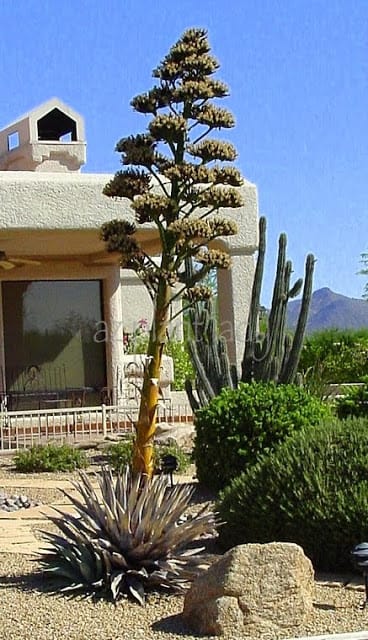
I am not completely sure what species this particular agave was. Note the ‘pup’ growing from the side of the agave.
There are two different styles of the flowering stalk (inflourescence). The paniculate, above, and the spiculate, below. You can clearly see the difference in the shape and design of the stalks.
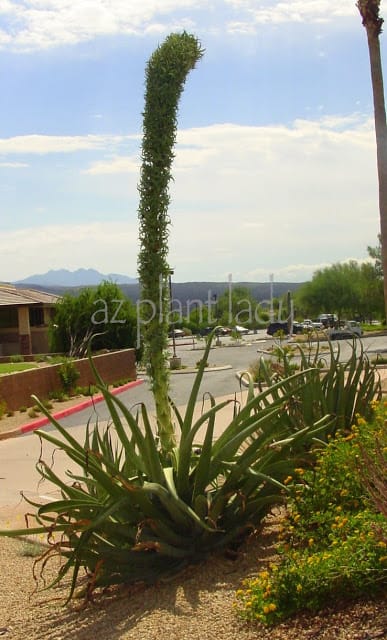
Octopus Agave (Agave vilmoriniana) I planted this agave (as a 5-gallon) in 1999 and it flowered in 2005.
Agave Reproduce in Several Ways
Agave reproduce both by flowering (seeds) and vegetatively (bulbils & offsets).
You can read more about how agave produce offsets (pups) and how to plant them from a previous post – Pups In The Garden…Not The Soft Cuddly Kind.
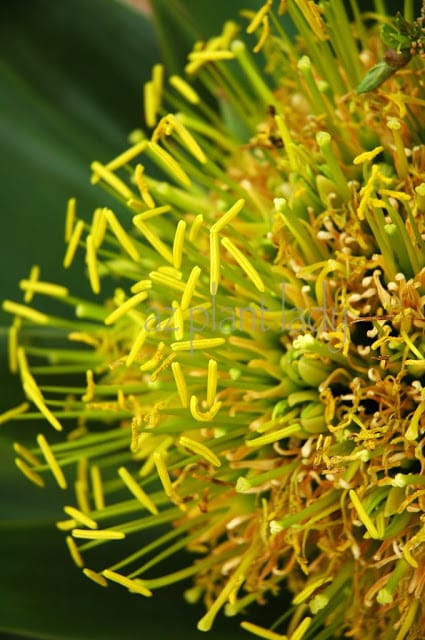
The flower of an Smooth Leaf Agave (Agave desmettiana) This is an agave from my garden, which was planted in 1998 and flowered in 2007.
You can see the small bulbils (baby agave) forming among the flowers above. The bulbils will continue to grow and will receive nourishment from the stalk. If left alone, the bulbils will eventually fall to the ground and root under ideal conditions. They can be removed from the flowering stalk and planted, but do best if left until they have formed at least four leaves.
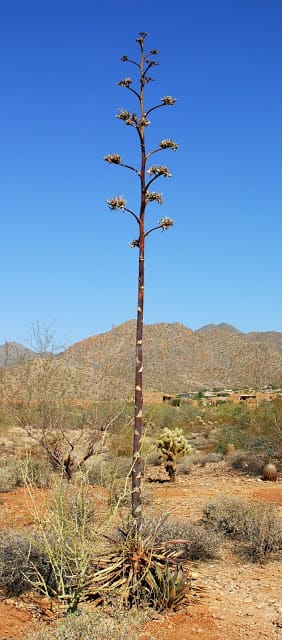
An agave in the desert that has died after flowering.
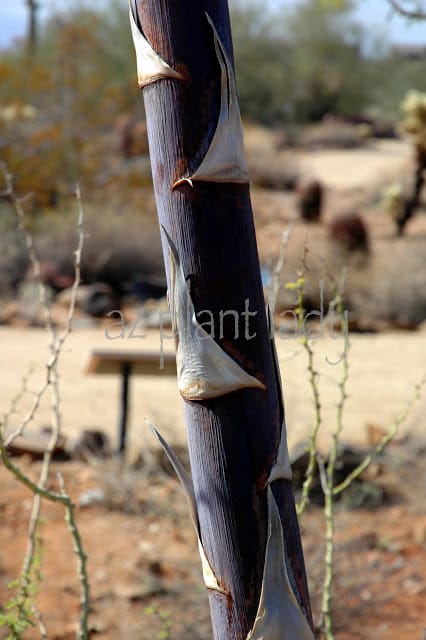
Close-up of the, now dead, stalk (inflourescence)
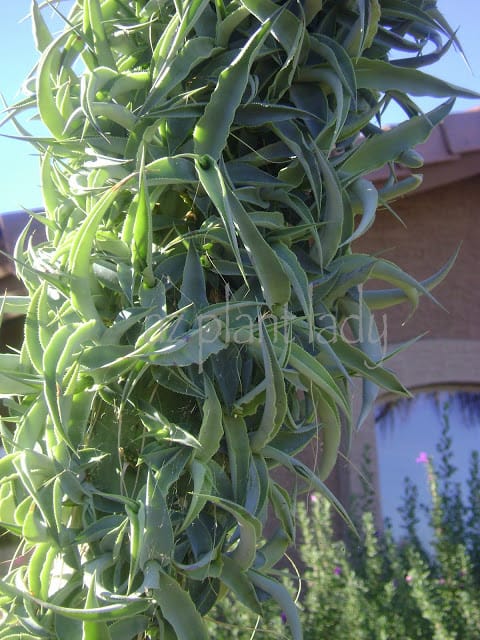
Bulbils on the flowering stalk of an Octopus Agave (Agave vilmorniana) They are ready to be picked off and can be planted in well-drained soil.
Early on as a horticulture student, I fell in love with Octopus Agave and I bought my first one at a plant sale. I planted it in a large pot and it thrived. Years later, the flowering stalk started to grow. I was both excited and a little sad. I was happy because it was finally achieving it’s crowning glory….and sad because I knew it would eventually die at the end after finishing it’s life’s work.
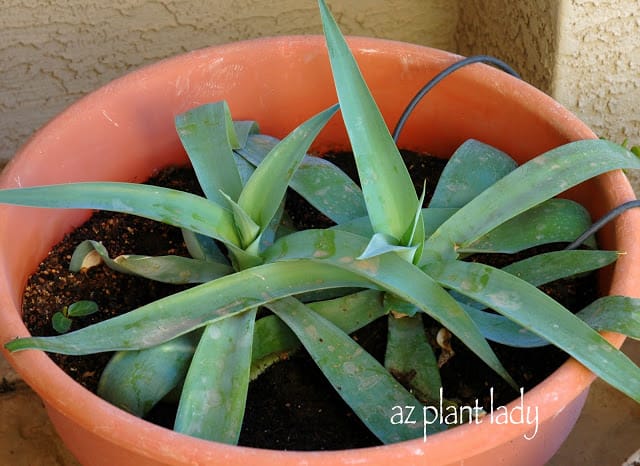
However, that is not the end of the story….my original Agave lives on. I took two bulbils from it’s stalk and planted them (above) and they are ready to be planted out in my garden. (Actually, I could have planted them much sooner).
**Note the little seedling coming up on the left side of the pot. My son planted the seed, but we aren’t sure what it is. I think he might have planted an apple seed. We shall see….

 Noelle Johnson, aka, 'AZ Plant Lady' is a author, horticulturist, and landscape consultant who helps people learn how to create, grow, and maintain beautiful desert gardens that thrive in a hot, dry climate. She does this through her consulting services, her online class Desert Gardening 101, and her monthly membership club, Through the Garden Gate. As she likes to tell desert-dwellers, "Gardening in the desert isn't hard, but it is different."
Noelle Johnson, aka, 'AZ Plant Lady' is a author, horticulturist, and landscape consultant who helps people learn how to create, grow, and maintain beautiful desert gardens that thrive in a hot, dry climate. She does this through her consulting services, her online class Desert Gardening 101, and her monthly membership club, Through the Garden Gate. As she likes to tell desert-dwellers, "Gardening in the desert isn't hard, but it is different."

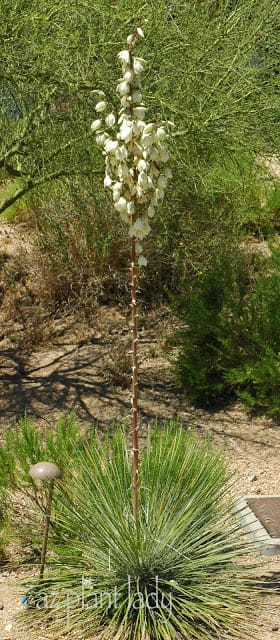

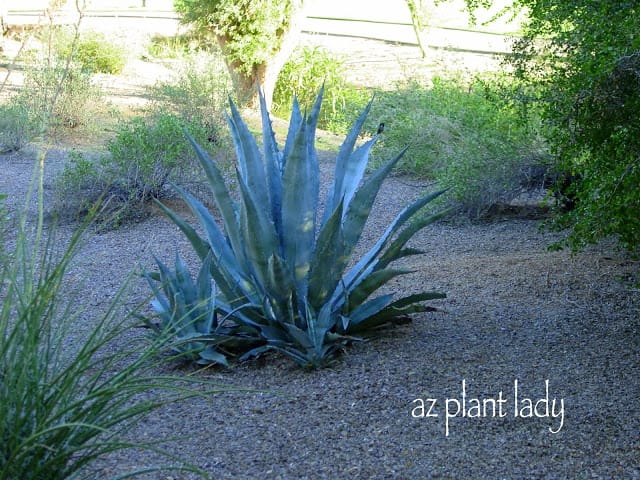
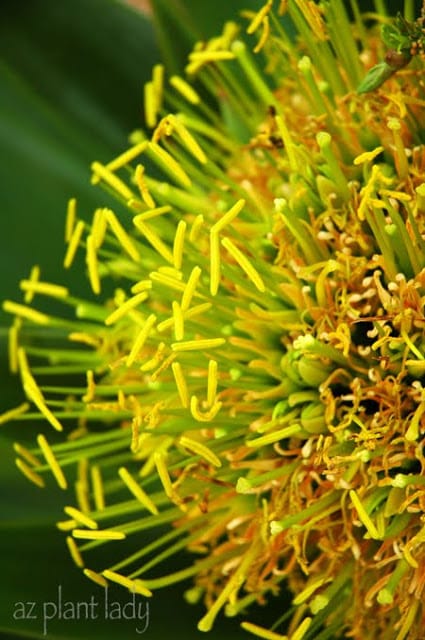
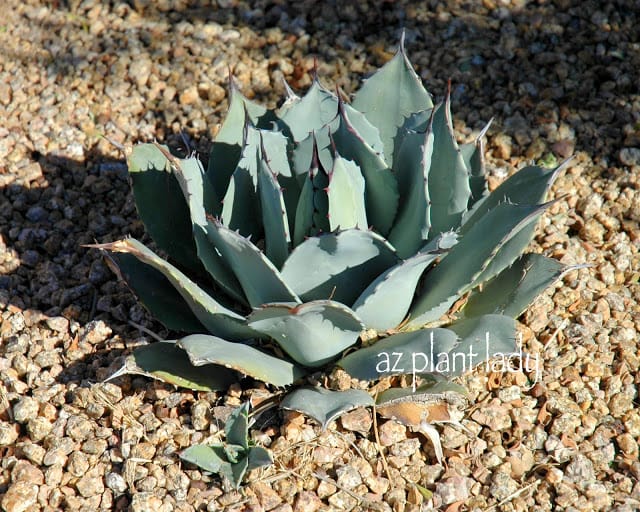







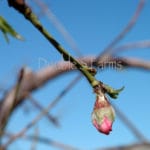
Fascinating and great info, because I don't know a thing about agave's! Wouldn't it be something if your little apple seedling developed into a tree producing juicy apples–in your climate;-)
Simply stunning, and yet somehow a little sad all at the same time. I'm glad your agave lives on though! I wonder how long it will be until they bloom!?
An extremely interesting post. I can't imagine how crazy those things would look in person…
What an interesting post! I love those stalks and have never seen such towering and striking flowers. Sad that the mother plants die but so neat that the next generation literally sprouts from those stalks. Once again, thank you for sharing.
This is a fascinating family of plants. I am always stopped in my tracks when I see a giant agave.
Agaves always remind me of Fred and Sarah, who had a yard full. I wonder what happened to the agaves after Sarah died, but haven't been by to look.
Very informative post, Noelle. We have several "century plants" growing in our salt sea air region. I don't know how they manage.
Wonderful post! Lovely! I love all the shots..especially the first one…magic!
Kiki
They are a totally different plant once they flower. I think I like them much better not flowering. So sad they die but then again the circle of life continues. Good luck with your new pups.
Wow… I am always learning something from you, Noelle. This story of waiting until the end of its life to flower and die is incredibly poignant and seems, to me, quite symbolic. How wonderful for you to witness the entire life-cycle of such unique and beautiful plants!
You are teaching me so much about desert plants Noelle. Maybe by the time I move there, I'll be ready??!!! 😉
It is kind of sad that life is over after they flower. They sure go out with a bang tho ~ the flower stalks are most impressive. I've never seen anything grow a foot a day ~ that would be fascinating to watch. I guess to avoid the sadness, you'd have to be ready to gather and plant the pups, right?
I had no idea that Agave blooms could get so tall!
I've always been interested in knowing more about Agaves Noelle as people do occasionally grow them around here.
Thank you for a very interesting and informative read!
You garden in such an alien environment to mine but I absoluetly love reading your blog Noelle. Wonderful photography as usual too :o)
RO xx
What an incredible post, thanks for the introduction. They look completely surreal to me, I had no idea they could send up stalks like that. I find plants that take years to bloom, then only do so once, somewhat heartbreaking. Beautiful pictures. 🙂 Rebecca
Hi Noelle, this is interesting but also inspiring. I guess we all live,possibly procreate and die. The only difference us and the agaves is the timelines! Cheers, catmint
I'd be a little sad when my agave starts flowering, but a nice story when it leaves some pups.
ps. love yr close-up – nice details!
Agaves are fascinating. 🙂
On my very first trip to Arizona, two years ago, I visited the Desert Botanic Gardens and took a tour. Our tour guide was such a fascinating man who told us all kinds of anecdotes about desert flora and fauna. I remember his telling about the agaves, and we actually saw a huge one that was flowering at the time. I think that was when I fell in love with these magnificent plants.
Great photos, Noelle, and a fascinating post! I'm glad to hear that the agaves produce pups to carry on–I'm not sure we were told that at the DBG. I love this idea of making one last great show before dying–sounds like a great way to go out.
This was so interesting, especially to see what the flower looks like. My Mother-in-law was excited this past summer that her century plant bloomed, she said it got to about 25 feet.
Hi,
Such good info about the AGave. I think that octopus agave is spectacular! I love agave nectar. good stuff.
Rosey
Nice post, Noelle. What did you do with the hundreds other octopus agave bulbils-sell them to nursery? Use them for clients? I bought a couple of those in San Francisco for $6 each!
They look like Dr. Seuss plants! How cool. Forty feet blows my mind. Thanks so much for the post, Noelle.
Hi Noelle, this is a bittersweet experience. I am so glad you have the pups and can keep the plant going in that way. The Agave are such majestic are architectural plants. I admire them a great deal. How funny about the seed! 🙂
Frances
Beautiful pictures! Its nice to see shots of an inflorescence that has just started to emerge, as I think that its just as exciting as the actual blooms. That octopus agave looks like a blast to propogate… haven't seen one around here yet.
Hi, Noelle, Wow! what a bewitching plant. I would love to see it … but thank you for enabling me to experience it vicariously. Pamela x
I am always amazed to see how tall the flower stalks are in comparisson to the plant.
Noelle, have you ever read any thing that helps you to understand why some flower stalks eventually produce bulbils and others don't? I am very curious about this! And I too wonder, what did you do with all the other little baby octopi?
Wow! that is so interesting. I never knew that happened to these plants. They are always so nice to see probably because I don't see them often, but to get those huge flowers as their grand finale. Very cool. Thanks for educating me. I love that about visiting blogs, there is always something to learn about especially in gardening.
We have some agaves here too although of different species maybe. I love your photos and am amused at the little seedling sowed by your son. He is learning a lot from the mother, like mother like son!
I remember the first time I saw some of these, was totaly amazed. Great post.
Noelle, your beautiful photographs almost always show a stunning landscape in the distance, as well as… the beautiful plant you feature. Wonderful post and I love the idea of living a full life and just before going out create a stellar flower that will casts seeds of life. Creating pups helps immortality too! ;>)
Noelle these pics are incredible – I have never seen the likes of this in my life before – I am in total amazement at these wonderful flowers and their terrific stems. Thankyou for sharing as I love seeing new things in nature 🙂 Rosie
Agaves are so interesting and unusual. I enjoyed your informative post. Pretty close up! 🙂
Great pics. Some of those agave stalks are incredible. There was one in my neighborhood last year that drew even with the telephone wires. And they do look like asparagus stalks, though I guess not too surprising since they do the same thing branching out.
Your agave and photography are stunning. I definitely need to start adding some hardy agave.